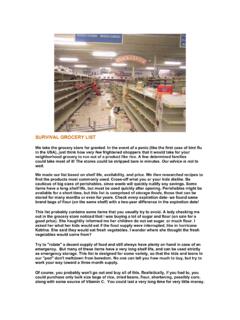Transcription of Classification of UNIT 1 CLASSIFICATION OF …
1 7 CLASSIFICATION of Microorganisms Important in the Food Industry: Bacteria, Yeasts and MoldUNIT 1 CLASSIFICATION OF MICROORGANISMS IMPORTANT IN THE FOOD INDUSTRY: BACTERIA, YEASTS AND MOLD Structure Objectives Introduction Various Types of Microorganisms Characteristics (Morphological, Cultural and Physiological) of Various Microorganisms Bacteria Molds Yeasts Let Us Sum Up Key Words Answers to Check Your Progress Exercises Some Useful Books OBJECTIVES The objectives of this unit are to enable you to understand the important genera of microorganisms associated with food. This unit gives a brief account of the morphological, physiological and cultural characteristics of various microorganisms.
2 After going through this unit, you should be able to: know the various types of microorganisms; explain the requirements for their growth; learn the CLASSIFICATION of these organisms based on their characteristics; and distinguish between the useful and harmful microorganisms. INTRODUCTION We already know that the microorganisms use our food as a source of nutrients for their own growth. This, of course can result in deterioration of the food. By increasing their numbers, utilizing nutrients, producing enzymatic changes and contributing off flavors by means of breakdown of a product or synthesis of new compounds they can spoil a food.
3 When the microorganisms involved are pathogenic, their association with our food supply is critical from a public health point of view. Therefore a CLASSIFICATION of different organisms and their growth requirements is required to prevent spoilage of foods. VARIOUS TYPES OF MICROORGANISMS Microbes are single-cell organisms so tiny that millions can fit into the eye of a needle. They are the oldest form of life on earth. Microbe fossils date back more than billion years to a time when the Earth was covered with oceans that regularly reached the boiling point, hundreds of millions of years before 8 Introduction dinosaurs roamed the earth. Without microbes, we couldn t eat or breathe.
4 Without us, they d probably be just fine. Bacteria Many of us know bacteria only as germs, invisible to naked eyes that can invade our bodies and make us sick. Few know that many bacteria not only coexist with us all the time, but help us do an amazing array of useful things like make vitamins, break down garbage, and even maintain our atmosphere. These are unicellular microorganisms that are classed as plants. A bacterial cell is about 1 m in length and somewhat smaller in diameter. Bacteria are classified according to their shape. Cocci are spherical, bacilli are cylindrical and spirilla and vibrios are spiral.
5 Bacterial spores are more heat resistant than yeast or mold spores to most processing conditions. Bacteria, with a few exceptions cannot grow in acid media in which yeasts and molds thrive. They multiply by binary fission . When a bacterium becomes mature it divides into two, these two become four and so on. Bacteria can be found virtually everywhere. They are in the air, the soil, and water, and in and on plants and animals, including us. A single teaspoon of topsoil contains about a billion bacterial cells (and about 120,000 fungal cells and some 25,000 algal cells). The human mouth is home to more than 500 species of bacteria.
6 Some bacteria (along with archaea) thrive in the most forbidding, uninviting places on Earth, from nearly-boiling hot springs to super-chilled Antarctic lakes buried under sheets of ice. Microbes that dwell in these extreme habitats are aptly called extremophiles. The growth of bacteria is very rapid and depends upon the nature of the food material, moisture, temperature and air. Some bacteria do not grow in air but temperature plays a major role in their growth, the optimum being generally 37 C for bacteria pathogenic to humans. Bacteria are very sensitive to acids and are destroyed in their presence even at temperature of boiling water.
7 Hence, most fruits being acidic can be easily sterilized at 100 C whereas vegetables being non-acidic require a higher temperature of 116 C. A bacterium s genetic information is contained in a single DNA molecule suspended in a jelly-like substance called cytoplasm. In most cases, this and other cell parts are surrounded by a flexible cytoplasmic membrane that is itself surrounded by a tough, rigid cell wall. A few species, such as the mycoplasmas, don t have cell walls. Even though bacteria have only one cell each, they come in a wide range of shapes, sizes, and colours. The important groups of bacteria are: a) Bacillus: rod-shaped.
8 B) Coccus: spherical. c) Coccobacillus: oval-shaped. d) Aerobes: require atmospheric oxygen for growth, , Acetobacter aceti. e) Facultative anaerobes: can grow with or without atmospheric oxygen. f) Obligate anaerobes: do not grow in atmospheric oxygen. 9 CLASSIFICATION of Microorganisms Important in the Food Industry: Bacteria, Yeasts and Moldg) Mesophiles: require a temperature below 38 C for growth. h) Obligate thermophiles: grow between 38 C and 82 C. i) Facultative thermophiles: grow over a wide range of temperatures covered by mesophiles and obligate thermophiles and below. j) Psychrotrophs: grow fairly well at refrigeration temperatures and some can even grow slowly at temperatures below freezing.
9 Some bacteria have natural colours. Certain species contain pigments, such as various chlorophylls, that make them naturally green, yellow, orange, or brown. Colonies of millions of bacteria may appear pink, yellowish, or white. Important Food Spoilage Bacteria Group Genus Acetics Acetobacter and Gluconobacter Lactics Lactobacillus, Leuconostoc, Pediococuus, Sreptococcus Butyrics Clostridium Propionics Propionibacterium Proteolytics Bacillus, Pseudomonas, Closridium, Proteus etc. Some useful bacteria The following bacteria are of great importance in the food processing industry.
10 Acetobacter sp. These bacteria, also known as vinegar bacteria , cause significant spoilage in the wine industry but are necessary for vinegar production. The important species are Acetobacter aceti, A. orleansis and They are very small, usually non-motile and generally do not form spores. These bacteria are aerobes and in the presence of oxygen convert ethyl alcohol to acetic acid. These bacteria can be easily destroyed by heating to 65 C. Lactobacillus sp. Different organisms of this group, also known as lactic acid bacteria , have different properties but all of them produce lactic acid from carbohydrates. The important species include Lactobacillus plantarum, Pediococcus cerevisiae, Leuconostoc mesenteroides, Streptococcus faecalis and Lactobacillus brevis.






